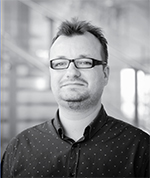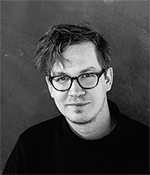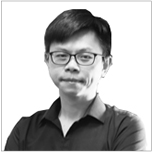1. Dr. Peter Buš
》Digital Architecture Research Centre (DARC),
》Kent School of Architecture and Planning
》University of Kent, UK

Peter Buš is a Lecturer in Digital Architecture at the Digital Architecture Research Centre (DARC) at Kent School of Architecture and Planning in Canterbury, UK. He previously gained experience as a postdoctoral researcher and co-lecturer at the Chair of Information Architecture, Institute of Technology in Architecture (ITA) at the Swiss Federal Institute of Technology (ETH) in Zürich, Switzerland. After he graduated with a Master of Arts in Architecture degree from the Academy of Fine Arts and Design in Bratislava in Slovakia, he founded a design research platform Peter Buš | Architecture | Computational Design | Research, where he explores the usage of generative computer coding and advanced modelling techniques for architecture and urban environments. Prior to obtaining his PhD degree in Architecture Theory and Design from the Department of Architectural Modelling (MOLAB) at the Czech Technical University in Prague, Peter worked as a practising architect and as a researcher at the Future Cities Laboratory SEC in Singapore. Peter is registered as a member of Slovak Chamber of Architects in Slovakia. He is currently enhancing his expertise in the field of digital fabrication at the Bartlett School of architecture in London in the post-professional postgraduate programme Design for Manufacture.
In his research agenda Peter concentrates on the development of custom-based computational environments, design workflows and simulation strategies within the field of Responsive and Adaptive Cities focusing on end-users’ perspective. This includes the development of design frameworks for urban and participatory design activities and experimental modelling and building strategies for architecture. The scope of his research is mainly focused on the phenomenon of emergence within natural and built environments and how complex relational qualities influence forms of architecture and cities. He investigates potentialities of computation, digital fabrication methods, and prototyping practices for their applications of construction deliveries in large-scale urban contexts and their capacities to respond to citizens’ necessities. Within this scope, the research aims to reveal, examine, and define to what extent the return of workshop models through digital making is capable to deal with large quantities of bespoke productions.
Peter teaches graduate master architectural design studio classes as well as Principles and Methods in Bio Digital Design in a recently opened postgraduate MSc course in Bio Digital Architecture at the KSAP. In his teaching agenda he concentrates on applicability of advanced computational design strategies for architecture and urban design following a paradigm of bio-integrated phenomena within built environments at many levels.
2. Martin Gsandtner
Designer, Zaha Hadid Architects, UK
 Martin Gsandtner is a designer at Zaha Hadid Architects, London. He is a guest reviewer at UCL UNIT 14 and workshop co-tutor at AD/AC introductory workshop at UCL, The Bartlett School of Architecture, London, United Kingdom.
Martin Gsandtner is a designer at Zaha Hadid Architects, London. He is a guest reviewer at UCL UNIT 14 and workshop co-tutor at AD/AC introductory workshop at UCL, The Bartlett School of Architecture, London, United Kingdom.
Previously, he taught at the Academy of fine Arts and Design in Bratislava, Slovakia. After he taught at the Academy of Arts, Architecture and Design in Prague, Czech Republic. He was running his own teaching studio at the private school of architecture “ARCHIP” and was a guest professor at the Technical University, Faculty of Architecture in Prague, Czech Republic.
He found together with the Jaroslav Fragner Gallery and the Academy of Arts, Architecture and Design “AAAD” the Experimental Architecture Biennial in Prague, Czech Republic.
He studied architecture at the University of Applied Arts, di:’angewandte and the composition of a 20th/21st century of music at the KONS in Vienna, Austria. He participated in the summer school at the PRATT Institute in New York, USA and the IAAC in Barcelona, Spain.
He exhibited and published his works around Europe. He worked and co-operated with several architectural practices around Europe.
His personal work is focused on speculative “experimental” prototypes in digital design and architecture.
Along diverse digital tactics and the discoveries of natural performance, he is looking into inventing intelligent spatial compositions answering the dialog between human user and artificial space in a better synergy and unexpected realm.
3. Shi-Yen Wu
Assistant Professor, D&A Lab Leader
National United University, Taiwan
 Shi-Yen Wu is a professional artist and assistant professor at the National United University. He gained his Master of Fine Art from the Taipei National University of the Arts. Shi-Yen has taught architecture design and international design competition, drawing and digital fabrication at Many leading academic institutions such as National Taiwan University of Science and Technology and National Taipei University of Technology, department of architecture. He recently established the digital fabrication lab in the National Taiwan University of Science and Technology with a focus on collaborating with international academia and organizations Such as UCL, ETH, AA and DEZACT (UK) to develop a new educational model in architectural construction. He has served as a visiting scholar in the UK and previously worked as a confidential secretary of the ministry of culture in the past. He is also a Curator of the Tibetan film festival in Taiwan. Furthermore, He also won the Red Dot Award and Green Product Award – Special prizes – The Best Concept Award.
Shi-Yen Wu is a professional artist and assistant professor at the National United University. He gained his Master of Fine Art from the Taipei National University of the Arts. Shi-Yen has taught architecture design and international design competition, drawing and digital fabrication at Many leading academic institutions such as National Taiwan University of Science and Technology and National Taipei University of Technology, department of architecture. He recently established the digital fabrication lab in the National Taiwan University of Science and Technology with a focus on collaborating with international academia and organizations Such as UCL, ETH, AA and DEZACT (UK) to develop a new educational model in architectural construction. He has served as a visiting scholar in the UK and previously worked as a confidential secretary of the ministry of culture in the past. He is also a Curator of the Tibetan film festival in Taiwan. Furthermore, He also won the Red Dot Award and Green Product Award – Special prizes – The Best Concept Award.
